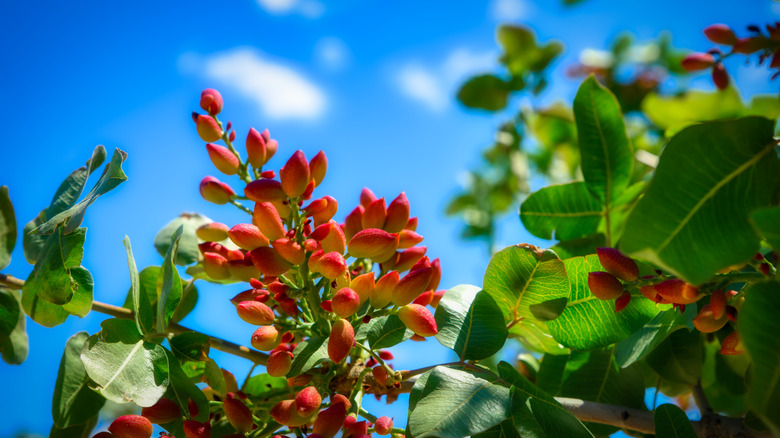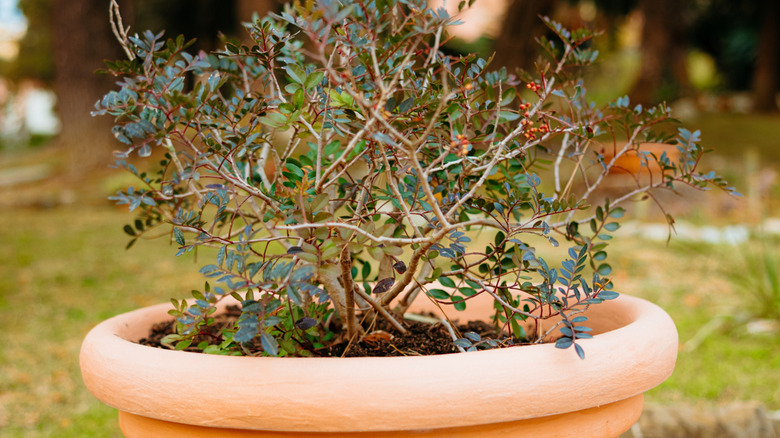Yes, You Can Grow A Pistachio Tree In A Container - But There's A Catch
The salty-sweet taste of a pistachio is so unique that growing your own pistachio tree (Pistacia vera) is worth the effort if your local climate supports it and you're up for a multi-year project. The trees will generally do well in USDA Hardiness Zones 4 through 9, but are more successful in some parts of that range than others. Pistachio trees grow best in New Mexico, Arizona, and especially California, where the San Joaquin and Sacramento valleys are hubs of commercial production. In these places with the precise combination of hot summers and chilly winter temperatures pistachio trees need to thrive, you can even grow pistachio trees in roomy containers, but not indefinitely. The tree, with its long taproot, must eventually be transferred into the ground and can only stay in the container for three to five years.
Pistachio trees need certain conditions to get to the stage where they produce their fruit, which includes the green seeds enclosed with a shell that make for delicious snacks. For your best chance at successfully getting pistachios, you'll need to grow at least two trees: a pollen-producing "male" and a pistachio-bearing "female." The trees also need plenty of time — for the first five years, they typically won't produce their drupes, which are eaten as nuts, so you shouldn't expect them to yield anything edible for the time you have them in containers. If you have limited space and water reserves, you can also just grow one pistachio tree ornamentally rather than growing one of each sex.
Tips for growing pistachio trees in containers
The journey toward container pistachio trees begins with selecting the right kind to grow. So you can tell how many male and female trees you have, it's best to grow grafted pistachio trees. You can buy budded pistachio trees that are a few years old from tree farms. It's not a good practice to start from seed, since not only will it take more time for the trees to develop, you can't tell if they will bear fruit or generate pollen. Two popular cultivars grown together are the fruit-bearing 'Kerman' and the pollen-producing 'Peters' trees.
Pistachio trees naturally grow in soil that's rich in sand and loam. For container growing, you can replicate this by mixing organic matter like peat along with some sand into soil that you pour into the large pot. After it's all mixed in, fill the container partway and lower the roots down into the center. It's vital to ensure the pot has good drainage, since the tree won't tolerate being waterlogged. This means overwatering, one of the biggest mistakes you can make with container gardening, is especially to be avoided when growing pistachio trees. Also, make sure you have an ideal location picked out for the potted pistachio trees. They'll need a bright, airy spot where they can get six hours or more of sun every day and be exposed to the breezes necessary for wind pollination.
How to transplant pistachio trees from containers into the garden
Closely monitor your potted pistachio tree, taking into account how many years it has been and the length of the growing taproot so you can know when to plant the nut tree in your yard for a bountiful harvest. There's also a particular time of year that's best to plant the tree: after the last frost in the beginning of the spring, after it come out of winter dormancy. You can also give it a prune around this time if it needs shaping. Once it's looking ready, loosen any dense soil to ensure there's adequate aeration around the roots. You can also add sand and organic matter like manure or compost into the hole you dig to plant the tree, which should be twice as large as the root ball's diameter.
A pistachio tree's taproots will keep growing as the trees reach a height of up to 30 feet, so give each tree a wide berth, 20 feet or more apart, when you plant them in the soil. They need some extra water when they're first planted, but over time, these desert-native trees will be able to tolerate drought. Too much humidity and pooling of water can cause more damage and affect nut production more than long, dry stretches. Yearly fertilizer in the spring months can help them obtain the right balance of nutrients.


